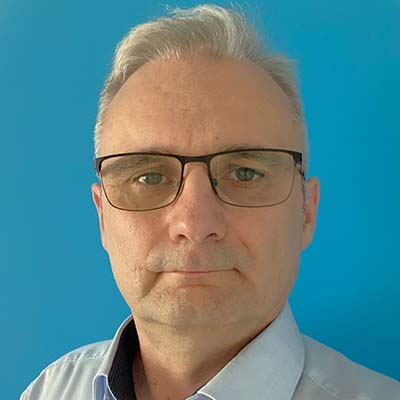

- Levente Lazar
- Senior Treasury Staff Manager, Middle Office Leader, Baker Hughes

- Tom Alford
- Deputy Editor, Treasury Management International
In his role heading up the Middle Office of global oil field services company Baker Hughes, Levente Lázár helped build an entire treasury function from scratch, the firm having just been carved out from GE. Always keen to learn new skills, the project was a labour of love, perfectly placing him for the next phase of his career as the company’s treasury undergoes its complex restructuring programme.
“I’m really grateful for the experience,” reflects Lázár speaking of his contribution to the ground-up creation of the firm’s treasury department. But taking on new challenges is what drives him, especially when he has a hunch that they will be beneficial.
Lázár had previously been at GE for some 17 years, culminating in his rise to CFO, GE Power Global Supply Chain Hungary. When Baker Hughes was carved out from GE in 2019, he intuitively took the opportunity to build upon his knowledge and experience, and moved firmly back into treasury. The need to develop processes, establish relationships and deploy the right technology stack to be able to hit the ground running in the new firm offered him just the kind of challenge he has always enjoyed.
Today, Lázár is responsible for activities such as the settlement of treasury instruments, including derivatives, and for financing, using products such as bonds, commercial paper, investments, and intercompany loans. But he kicked off the early days at Baker Hughes by engaging with a full TMS implementation. This saw FIS’ Quantum being deployed alongside a host of other supporting technologies. Learning how to set up a new TMS was, by his own admission, a steep learning curve.
The project, which took about one year from a standing start, saw Lázár working with advisers from PwC and FIS. As part of the set-up process he also designed and went live with an intercompany netting system, working with Coprocess (now owned by GTreasury) to create a net settlement solution for all Baker Hughes entities.
“I’ve been a treasurer most of my career, and this was my first implementation experience; that had been missing from my career path, so I learnt a great deal,” explains Lázár of his thirst for discovering the new.
Thrown in at the deep end with concepts such as project management, workflows, and user acceptance testing it was, he declares “both interesting and important to understand the operational aspects of treasury”. Indeed, with his role in the middle office, handling all the settlements, he essentially had oversight of every transaction in the system.
Thriving under pressure
Of course, Lázár has built up his skill set over the years, having first entered treasury “pretty much incidentally” back in 1996 at Szerencsejáték, the national lottery company of his native Hungary. Despite his initial unplanned approach, he remained here for two years before moving on to Hungary’s Central Clearing House and Depository, taking on a role as Credit Risk Manager, responsible for the valuation of collaterals such as government bonds and Treasury bills. His lengthy career at GE followed, before the carve-out took him to pastures new.
Probing treasury’s initial appeal, and sustaining interest over the years, elicits from Lázár a clear-cut response. “The simple answer is that I have found treasury extremely interesting because every change in the business, and in the external environment, impacts treasury in one way or another.”
Indeed, some unplanned events have served to make treasury more exciting than perhaps some would wish for. “There are massive macroeconomic shocks such as the Russian crisis in 1998, Lehman’s collapse in 2008, and the pandemic. And on the business side, new acquisitions or divestitures are significant events, and of course there is always a new project that treasury needs to support.
“For that, I believe that a certain level of readiness and flexibility is required to properly address any non-routine task. But when you are facing a crisis, then you are really on the edge. That’s when you are working under pressure.”
Thankfully, major business crises are rare events, but when they occur, clear thinking is essential. “They may happen two or three times during your career, as either internal or external events, and they can be a real challenge,” admits Lázár. “But when they do, the adrenalin kicks in, and it keeps you thinking and alert as to how best to take the next step, and how to stay calm. And, generally, that’s true in treasury because you’re always on the front line.”
The right mindset
There are certain key behavioural skills and personality traits that Lázár has found to be beneficial across his treasury career when handling both the pressurised moments and the day-to-day tasks. “First, you need an analytical mindset. This is particularly true in risk management but also in the operational work. It is also important to learn how to communicate, and collaborate effectively, both within the business and externally. Treasury is often the messenger, and that means always finding the right tone and level for each scenario,” he says.
“Then you need a strong sense of execution, and by that I mean effective time management and prioritisation: there is no room for procrastinating when there is an FX settlement run with a strict deadline.” In addition, he says, a well-developed, experience based “treasury intuition” is vital. “If you are facing a crisis, you will often need to make quickfire decisions, and then you may have to rely on your experience and gut feeling based on that.”
Professionally, Lázár believes that it is important for every treasurer to understand how their organisation financially measures its performance, and what its key financial metrics are. “You need to understand how the P&L and balance sheet look, and how you derive your cash flow statements, because it’s important to be aligned with the CFO on targets, to be able to support the overarching business objectives.”
In his time as a CFO, Lázár managed the FP&A team and planning as well as the controllership team and accounting functions among many tasks. The analytical side of his personality was well met in this role, with strict targets imposed. But other personal traits, he felt, were left unused. However, as a treasurer, he feels that all aspects of his character are called upon. Nonetheless, his experience has given him a first-hand appreciation of how treasury’s focus on financial detail supports the CFO’s broad-based approach to financial strategy.
As a CFO, Lázár had broad financial targets. But as business treasurer, he has had objectives too, with responsibility for optimising certain P&L lines, such as FX remeasurement, within the wider scope of the CFO’s business plan. This requires an understanding of how differentials arise, and how certain risk mitigating actions, such as hedging, impact the business’ overall financial performance.
“If you deliver on these forecasted targets, it’s good. If you don’t deliver, you have to explain. You may have a good explanation, but these numbers are always being reviewed alongside metrics from other functions, and they can change the CFO’s decision-making. It’s why it’s very important for the treasurer to understand the business and its exposures and goals.”
The gatekeeper
With many years in the treasury hot seat, and having experienced the essential connection between the CFO and treasury, Lázár is undoubtedly well prepared for most eventualities. Today’s commercial environment seems particularly volatile, but for him, tackling current events is no different than at any other time of stress.
“I don’t think today’s world is more volatile or pressurised than before,” he comments. He offers a specific example in explanation. During the Lehman Brothers’ crisis, there was a time when the credit markets were frozen, he recalls. At the time, GE had a USD functional operation in India that had accumulated some excess USD. The cash desk of the local treasury, under pressure to fund payroll, wanted to use that cash for the group in India but needed it in INR. It was not able to arrange finance through its normal sources.
Lázár was asked to create an INR loan and swap, where treasury, guided by policy, would sell USD against INR on the near leg, and buy the USD back on the far leg at loan maturity. “Normally it works, as it is essentially a USD synthetic loan, combining the INR loan and the swap,” he notes. “But when I looked at the market, I could see that there was a 40% spread in the USD/INR market. Normally it would be just a few basis points, but at that time everyone wanted to buy USD as a safe haven, and no one wanted emerging currencies like INR. There was no hedging structure to cover that, so I knew if we proceeded, we’d be locking down a 40% loss.”
The company’s traders would have questioned this further down the line, but based on his analysis, Lázár was able to act as a “gatekeeper”, politely advising and persuading his treasury colleague that despite the frozen markets, this deal could not happen.
“There is always some sort of challenge. It’s in the nature of treasury – we’re on the front line. But every decade or so there is a real crisis to tackle, and if you’re not smart, it can cost the business a lot of money. That’s why I say it takes an analytical mind, execution skills, intuition based on professional knowledge, experience, strong communication, and collaboration in situations like this.”
Exploring, networking, learning
It’s apparent that Lázár has always been able to draw upon a varied and hard-won knowledge base, providing solutions for what may seem impossible circumstances. He has that ability because he innately has what he refers to as “the right behavioural skills”, and is driven to constantly seek out and update his professional and technical skills.
Treasury technology is one area that has always interested him. But he believes that there needs to be a reason for using technology; it is not an end in itself. In his current setting, within a diverse and globally distributed company, with a relatively complex structure that is growing by acquisition, creating an effective payment structure is a major challenge. It has generated his particular interest in establishing an in-house banking and centralised payments structure. This, he envisions, will use virtual accounts and multicurrency cash pooling to serve the firm’s multilateral netting and payment system.
“In technology terms, this to me is a low-hanging fruit because banks can now offer effective cash management solutions – and a good TMS should handle the required processes in-house,” he comments. “But it assumes a POBO and COBO entity, which requires the preparation of a number of legal documents, and many other issues to be considered. This is not an easy process.”. But, if this is done successfully, it would be an extremely effective way of centralising liquidity and financing. “With the world going in this direction, it is on my to-do list, along with virtual accounts.”
Despite being a firm advocate of TMS ownership, Lázár is aware that, even for the best of them, there are functions still open to improvement. He believes the fintech community has a role to play here. But there is a huge choice on the market, and sifting through the contenders can be a challenge in itself. It requires the individual treasurer to go exploring.
“I consume a lot of treasury content, such as TMI’s articles and podcasts, as I try to be up to date with industry developments. I find treasury conferences and professional networking events very useful too, sharing experiences and finding inspiration from how others have approached the same treasury challenges that I have tackled.”
His investigations have uncovered some exciting tools. As a case in point, in settling some of his bank contracts, such as FX deals, netting is used with certain banks because it decreases counterparty exposures on both sides. Without netting, each individual deal is paid separately on a gross basis, based on outputs from a confirmation matching tool. But netting first requires volumes to be agreed, and this has traditionally been handled offline, through email exchanges.
However, having discovered a fintech solution that sits between the bank and the business, handling the confirmation matching and the netting, and then automating payments on the bank side, all manual touch points in the process are removed. It’s a winning combination for Lázár. Introduction to this solution came by way of a chance conference meeting. “But if I’m not at the conferences, not networking, and not reading articles about these solutions, then I would never know about them.”
Free from ‘technofear’
Being involved in some major technology implementation projects (including TMI’s Best Automation Project 2022), technology has proven to be a labour of love for Lázár. Today, he considers a reliable TMS as “the utmost important enabler” for a treasurer and their organisation.
“If all our liquidity positions, exposure management, financing and investment instruments are centralised in a TMS system, then we have one place where all data is consolidated. And based on that data, better decisions can be made. If you don’t have a TMS, it is much harder to make those decisions. You may find yourself flying somewhat blindly.”
A TMS is not a ‘set-and-forget’ solution though, with Lázár and his team constantly seeking process improvements within. “We won an award for one of our enhancements, by reducing process cycle times and improving data quality in Quantum. Now, with the TMS designed and optimised for our business needs, relatively few people are needed to process large and complex volumes of treasury data.”
Essentially, that TMS is being used as a treasury sub ledger for all financial data, he explains. “Even if it’s from a remote location, everything is in there. It gives us a single source of truth. It means we can manage all the settlements, but also have an accurate view of our cash positions for forecasting. And we have all our derivatives and mark-to-market (MTM) data available, so at any point we also have a clear view across our portfolio.” The TMS is seen as a key enabler from Lázár’s perspective, going so far as to warn others that “if you don’t have an integrated system, that’s a disadvantage”.
Stepping beyond core treasury technology into the world of AI and blockchain unsurprisingly holds no fear for Lázár. “There is certainly room for these technologies, and I believe they will develop quickly,” he states. AI is already established within some more advanced cash forecasting tools, and blockchain is now being used to create smart contracts. For the latter, he has a ready use case to offer.
“Interest rate swap contracts are phrased in different ways by banks, although the economic content is the same in each,” he notes. “A solution where these contracts are matched between the bank and the business in a standardised blockchain-based repository would be of great benefit, and save a lot of manual checking during the confirmation process.”
He continues: “Commodities traders often work with many different types of commodity. In my experience, rather than having a single commodity settlement desk, banks have specialised groups for each commodity [base metals, petrochemicals and so on]. But instead of having to check and sign each legally binding contract, going through each component one by one, it would be a great help if there was a standard blockchain-type of contract repository – a smart contract repository – where contracts could be automatically matched. That would be an efficiency, and it would reduce risk.”
Using AI to check for contract discrepancies before signing may seem unsettling for some – these are legally binding contracts after all – and Lázár voices his concerns too. But, he says, “I don’t see a reason why eventually AI should not be doing what is currently done by a human.” The greatest concern for him is the integrity and security of company data within an AI environment. “But we’re going to get there eventually; we just can’t avoid it. It’s probably going to take a few years because banks are conservative, and we are conservative too, as we should be as a company.”
Follow your intuition
With the advent of new tools, and new pressures, the role of treasury in the longer term will change, insists Lázár. The key to its future success is to continue adding value and providing compelling advice to the CFO and to the business community, he says. “Risk management, project support, financing optimisation – all these require treasury support and expertise. It’s why I believe treasury should be linked to the business as much and as close as possible.”
While he knows that treasury is currently having to process large volumes of data while managing with relatively few people, Lázár believes that the level of automation in the department, in the long run, will only increase. “Not every aspect is easy to automate – regulatory reporting, as it becomes more complex, could slow progress – but we are moving towards increased automation. The skill of the treasurer will be in interpreting and making decisions using that data. That’s where the real value will be added.”
With treasury becoming a “key enabler for decision-making”, Lázár urges anyone considering entering treasury as a career “to be curious, eager to learn and able to follow their intuition”. He also encourages treasury candidates to actively pursue what makes them happy.
“Sometimes you have to take a risk with a job. You never really know what it will be until you try, but sometimes you will have a good feeling about something. I’ve taken that approach in my career, and generally it has worked, so I encourage everyone to follow their intuition, because sometimes that’s all you have. And, you know, I really love what I’m doing.”



